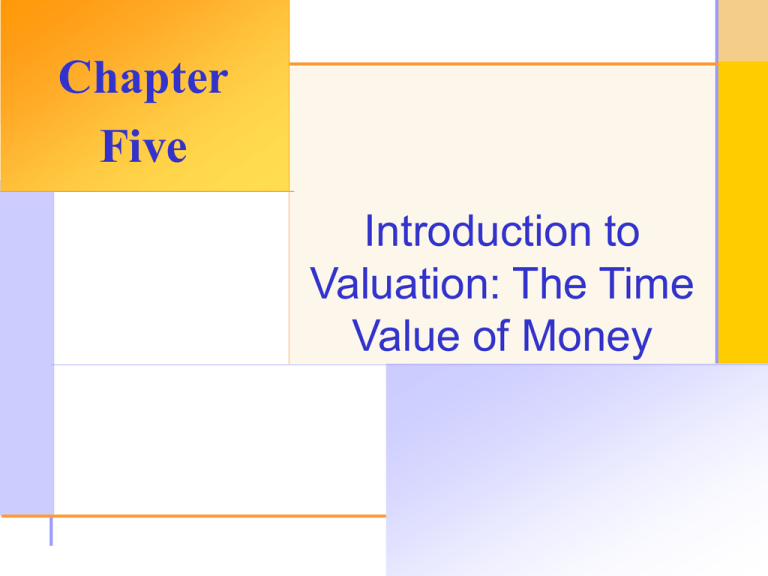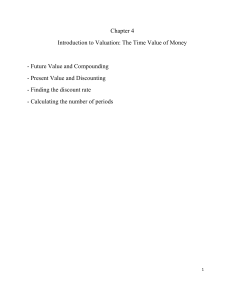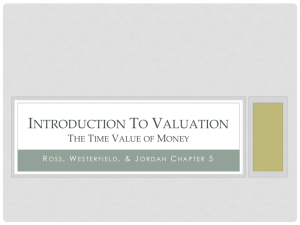
Chapter
Five
Introduction to
Valuation: The Time
Value of Money
© 2003 The McGraw-Hill Companies, Inc. All rights reserved.
5.1
Key Concepts and Skills
Be able to compute the future value of an investment
made today
Be able to compute the present value of cash to be
received at some future date
Be able to compute the return on an investment
Be able to compute the number of periods that
equates a present value and a future value given an
interest rate
Be able to use a financial calculator and/or a
spreadsheet to solve time value of money problems
5.2
Chapter Outline
Future Value and Compounding
Present Value and Discounting
More on Present and Future Values
5.3
Basic Definitions
Present Value – earlier money on a time line
Future Value – later money on a time line
Interest rate – “exchange rate” between money
received today and money to be received in the future
Discount rate
Cost of capital
Opportunity cost of capital
Required return
5.4
Future Value – Example 1 – 5.1
Suppose you invest $1000 for one year at 5% per year. What
is the future value in one year? The future value is
determined by two components:
Interest = $1,000(.05) = $50
Principal = $1,000
Future Value (in one year) = principal + interest
= $1,000 + $50
= $1,050
Future Value (FV) = $1,000(1 + .05)
= $1,050
Suppose you leave the money in for another year. How much will you
have two years from now?
FV = $1,000(1.05)(1.05) = $1,000(1.05)2 = $1,102.50
5.5
Future Value: General Formula
FV = PV 1 + r
t
FV = future value
PV = present value
r = period interest rate, expressed as a decimal
T = number of periods
Future value interest factor = (1 + r)t
5.6
Effects of Compounding
Simple interest – earn interest on principal only
Compound interest – earn interest on principal and reinvested
interest
Consider the previous example
FV with simple interest = $1,000 + $50 + $50
= $1,100
FV with compound interest
= $1,000(1.05)(1.05)
= $1,000(1.05)2
= $1,102.50
The extra $2.50 comes from the interest of 5% earned on
the $50 of interest paid in year one.
5.7
Calculator Keys
Financial calculator function keys
FV = future value
PV = present value
PMT = the periodic payment for an annuity or perpetuity
I/Y = period interest rate
P/Y must equal 1 for the I/Y to be the period rate
Interest is entered as a percent, not a decimal
N = number of periods
Most calculators are similar in format
5.8
Future Value – Example 2
Suppose you invest $1000 for 5 years at 5% interest. How
much will you have at the end of the five years?
Formula Approach:
FV = PV 1+ r
t
1000(1.05)5
= $1, 276.28
Calculator Approach:
1,000
PV
0
PMT
5
N
5
I/Y
FV
-1,276.28
5.9
Future Value – Example 2 continued
The effect of compounding is small for a small
number of periods, but increases as the number of
periods increases.
For example, if were to invest $1,000 for five years at
5% simple interest, the future value would be $1,250
versus $1,276.28 when the interest is compounded
(see calculation on the previous page).
The compounding effect makes a difference of
$26.28.
5.10
Future Value – Example 3
Compounding over long periods of time makes a
huge difference
Suppose you had a relative who deposited $10 at 5.5%
interest 200 years ago.
How much would the investment be worth today?
Formula Approach
FV PV 1 r
10 1.055
t
200
$447,189.84
Calculator Approach
10
PV
0
PMT
200
N
5.5
I/Y
FV
-447,189.84
5.11
Future Value – Example 3 continued
What is the effect of compounding?
Using simple interest
FV PV PV I t
10 10 .055 200
$120
Using compound interest
FV PV 1 r
10 1.055
t
200
$447,189.84
5.12
Future Value as a General Growth Formula
Suppose your company expects to increase unit sales of
widgets by 15% per year for the next 5 years. If you currently
sell 3 million widgets in one year, how many widgets do you
expect to sell in 5 years?
Formula Approach
FV PV 1 r
t
3, 000, 000 1.15
6, 034, 072
5
Calculator Approach
3,000,000
PV
0
PMT
1
N
15
I/Y
FV
-6,034,072 units
5.13
Quick Quiz – Part I
What is the difference between simple interest and
compound interest?
Suppose you have $500 to invest and you believe that you
can earn 8% per year over the next 15 years.
How much would you have at the end of 15 years using compound
interest?
How much would you have using simple interest?
5.14
Present Values – 5.2
How much do I have to invest today to have some specified
amount in the future? Start with the formula for FV and
rearrange
FV PV 1 r
t
Rearrange to solve for PV:
PV
FV
1 r
t
When we talk about discounting, we mean finding the present
value of some future amount.
When we talk about the “value” of something, we are talking
about the present value unless we specifically indicate that we
want the future value.
5.15
Present Value – One Period Example
Suppose you need $10,000 in one year for the down payment
on a new car. If you can earn 7% annually, how much do you
need to invest today?
Formula Approach
PV
FV
1 r
t
10, 000
1.07
1
$9,345, 79
Calculator Approach
10,000
FV
0
PMT
1
N
7
I/Y
PV
-9,345.79
5.16
Present Value – Example 2
You want to begin saving for you daughter’s college education
and you estimate that she will need $150,000 in 17 years. If
you feel confident that you can earn 8% per year, how much
do you need to invest today?
Formula Approach
PV
FV
1 r
t
150, 000
1.08
17
$40,540.34
Calculator Approach
150,000
FV
0
PMT
17
N
8
I
PV
-$40,540.34
5.17
Present Value – Example 3
Your parents set up a trust fund for you 10 years ago that is
now worth $19,671.51. If the fund earned 7% per year, how
much did your parents invest?
Formula Approach
PV
FV
1 r
t
19, 671.51
1.07
10
$10, 000
Calculator Approach
19,671.51
FV
0
PMT
10
N
7
I/Y
PV
-$10,000
5.18
Present Value – Important Relationships
For a given interest rate:
The longer the time period, the lower the present value
For a given time period
The higher the interest rate, the smaller the present value
What is the present value of $500
To be received in 5 years?
To be received in 10 years?
Given a discount rate of 10%
Given a discount rate of 15%
5.19
Quick Quiz – Part II
What is the relationship between present value and
future value?
Suppose you need $15,000 in 3 years. If you can earn
6% annually, how much do you need to invest today?
If you could invest the money at 8%, would you have
to invest more or less than your answer above? How
much?
5.20
The Basic PV Equation - Refresher
FV PV 1 r
t
There are four parts to this equation
PV, FV, r and t
If we know any three, we can solve for the fourth
If you are using a financial calculator, the calculator
views cash inflows as positive numbers and cash
outflows as negative numbers.
When solving for time (N) or rate (I/Y) using a
financial calculator, you must have both an inflow
(positive number) and an outflow (negative number),
or you will receive an error message
5.21
Discount Rate – 5.3
We often want to know the implied interest rate for
an investment
Rearrange the basic PV equation and solve for r
FV= PV 1+ r
1
t
t
FV
r=
-1
PV
5.22
Discount Rate – Example 1
You are considering at an investment that will pay
$1200 in 5 years if you invest $1000 today. What is
the implied rate of interest?
Formula Approach
1
t
FV
r=
-1
PV
1
5
1, 200
-1
1,
000
3.714%
Calculator Approach
1000 +/PV
1200
FV
0
PMT
5
N
I/Y
3.714%
5.23
Discount Rate – Example 2
Suppose you are offered an investment that will allow you to
double your money in 6 years. You have $10,000 to invest.
What is the implied rate of interest?
Formula Approach
1
t
FV
r=
-1
PV
1
6
20, 000
-1
10, 000
12.25%
Calculator Approach
20,000
FV
10,000 +/PV
0
PMT
6
N
I/Y
12.25%
5.24
Discount Rate – Example 3
Suppose you have a 1-year old son and you want to provide
$75,000 in 17 years towards his college education. You
currently have $5,000 to invest. What interest rate must you
earn to have the $75,000 when you need it?
Formula1 Approach
FV t
r=
-1
PV
1
17
75, 000
-1
5,
000
17.27%
Calculator Approach
75,000
FV
5,000 +/PV
0
PMT
17
N
I/Y
17.27%
5.25
Quick Quiz – Part III
Suppose you are offered the following investment
choices:
You can invest $500 today and receive $600 in 5 years.
The investment is considered low risk.
You can invest the $500 in a bank account paying 4%.
What is the implied interest rate for the first choice and
which investment should you choose?
5.26
Finding the Number of Periods
Start with basic equation and solve for t
FV = PV 1+ r
t
FV
t
= 1+ r
PV
FV
ln
= t.ln 1+ r
PV
FV
ln
PV
t=
ln 1+ r
5.27
Number of Periods – Example 1
You want to purchase a new car and you are willing to pay
$20,000. If you can invest at 10% per year and you currently
have $15,000, how long will it be before you have enough
money to pay cash for the car?
Formula Approach
FV
ln
PV
t=
ln 1+ r
20,000
ln
15,000
=
ln 1.10
3.02 years
Calculator Approach
20,000
10,000 +/0
10
N
FV
PV
PMT
I/Y
3.02 years
5.28
Number of Periods – Example 2
Suppose you want to buy a new house. You currently have
$15,000 and you figure you need to have a 10% down
payment. If the type of house you want costs about $200,000
and you can earn 7.5% per year, how long will it be before
you have enough money for the down payment?
Formula Approach
FV
ln
PV
t=
ln 1+ r
20,000
ln
15,000
=
ln 1.075
3.98 years
Calculator Approach
20,000
15,000 +/0
7.5
N
FV
PV
PMT
I/Y
3.98 years
5.29
Quick Quiz – Part IV
Suppose you want to buy some new furniture for
your family room. You currently have $500 and the
furniture you want costs $600. If you can earn 6%,
how long will you have to wait if you don’t add any
additional money?
5.30
Spreadsheet Example
Use the following formulas for TVM calculations
FV(rate,nper,pmt,pv)
PV(rate,nper,pmt,fv)
RATE(nper,pmt,pv,fv)
NPER(rate,pmt,pv,fv)
The formula icon is very useful when you can’t
remember the exact formula
Click on the Excel icon to open a spreadsheet
containing four different examples.
5.31
Work the Web Example
Many financial calculators are available online
Click on the web surfer to go to Cigna’s web
site and work the following example:
You need $50,000 in 10 years. If you can earn 6%
interest, how much do you need to invest today?
You should get $27,920
5.32
Table 5.4
5.33
Summary 5.4
The basics of time value of money have been
covered. You should be able to:
Calculate the future value of an amount given
today
Calculate the present value of an amount to be
received in the future
Find the interest rate
Find the number of periods







